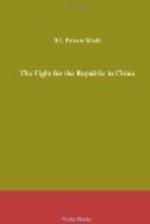Yuan Shih-kai first emerges into public view in 1882 when, as a sequel to the opening of Korea through the action of foreign Powers in forcing the then Hermit kingdom to sign commercial treaties, China began dispatching troops to Seoul. Yuan Shih-kai, with two other officers, commanding in all some 3,000 men, arrived from Shantung, where he had been in the train of a certain General Wu Chang-ching, and now encamped in the Korean capital nominally to preserve order, but in reality, to enforce the claims of the suzerain power. For the Peking Government had never retreated from the position that Korea had been a vassal state ever since the Ming Dynasty had saved the country from the clutches of Hideyoshi and his Japanese invaders in the Sixteenth Century. Yuan Shih-kai had been personally recommended by this General Wu Chang-ching as a young man of ability and energy to the famous Li Hung Chang, who as Tientsin Viceroy and High Commissioner for the Northern Seas was responsible for the conduct of Korean affairs. The future dictator of China was then only twenty-five years old.
His very first contact with practical politics gave him a peculiar manner of viewing political problems. The arrival of Chinese troops in Seoul marked the beginning of that acute rivalry with Japan which finally culminated in the short and disastrous war of 1894-95. China, in order to preserve her influence in Korea against the growing influence of Japan, intrigued night and day in the Seoul Palaces, allying herself with the Conservative Court party which was led by the notorious Korean Queen who was afterwards assassinated. The Chinese agents aided and abetted the reactionary group, constantly inciting them to attack the Japanese and drive them out of the country.
Continual outrages were the consequence. The Japanese legation was attacked and destroyed by the Korean mob not once but on several occasions during a decade which furnishes one of the most amazing chapters in the history of Asia. Yuan Shih-kai, being then merely a junior general officer under the orders of the Chinese Imperial Resident, is of no particular importance; but it is significant of the man that he should suddenly come well under the limelight on the first possible occasion. On 6th December, 1884, leading 2,000 Chinese troops, and acting in concert with 3,000 Korean soldiers, he attacked the Tong Kwan Palace in which the Japanese Minister and his staff, protected by two companies of Japanese infantry, had taken refuge owing to the threatening state of affairs in the capital. Apparently there was no particular plan—it was the action of a mob of soldiery tumbling into a political brawl and assisted by their officers for reasons which appear to-day nonsensical. The sequel was, however, extraordinary. The Japanese held the Palace gates as long as possible, and then being desperate exploded a mine which killed numbers of Koreans and Chinese soldiery and threw the attack into confusion. They then fought their way out of the city escaping ultimately to the nearest sea-port, Chemulpo.




